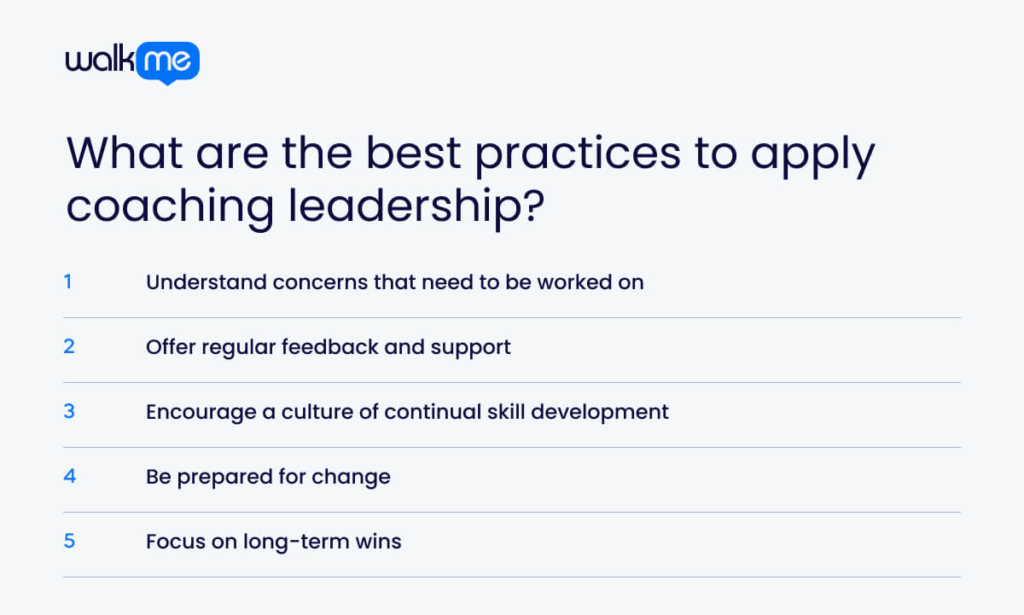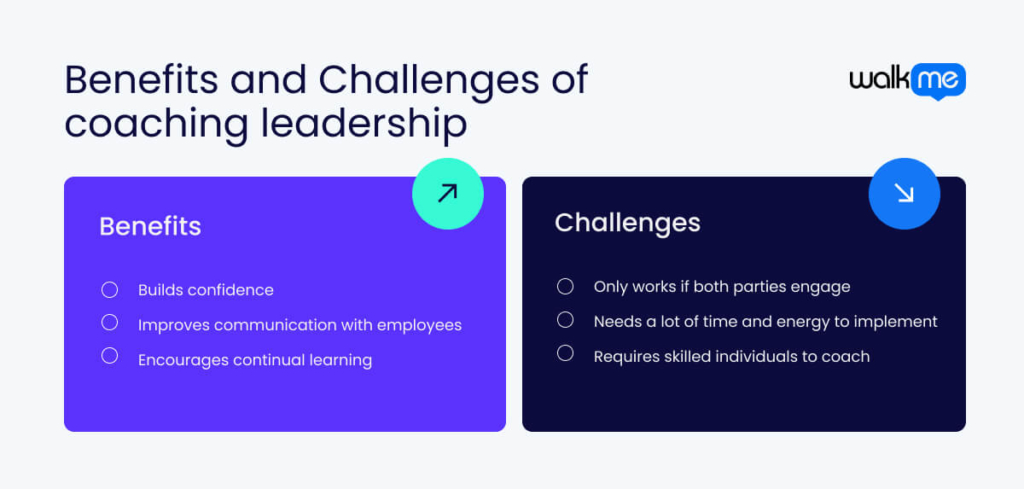For many people, leadership is about having power. It involves giving direction and shaping organizational behavior with rewards and punishments.
But, when you think of the best leaders you’ve known, you probably don’t picture someone who always gives orders and shows off their expertise. Instead, you likely remember someone who stood by you and cared about learning and development.
This is the coaching leadership style. Unlike traditional styles, coaching leadership helps individuals unlock their potential and find solutions.
This article will explore coaching leadership, discuss its traits, and explain how it differs from other styles. We’ll also look at examples of effective coaching leaders. Finally, we will review best practices for implementing this style and its pros and cons.
What is coaching leadership?
Coaching leadership is a style where a leader focuses on developing employees as individuals. They ask questions, listen actively, and create a space for growth.
Leaders encourage their teams to think critically, set goals, and find the best ways to achieve them. It’s like giving them the keys to explore.
This style isn’t hands-off. Rather, coaching leaders are deeply engaged. They provide guidance, feedback, and support when needed. They help the team stay on track while allowing flexibility.
Defined by Paul Hersey and Kenneth Blanchard in the 1960s, its positive approach helps develop new skills. It also helps employees align with company goals and builds a confident culture. Leaders who coach are often seen as valuable mentors.
How is coaching leadership different from other leadership styles?
Coaching leadership focuses on partnership and achieving goals. Here are the differences with other leadership styles:
Democratic leadership
Democratic leadership encourages participation in decision-making and guiding discussions, but it does not involve developing individual employees’ skills.
Transactional leadership
Transactional leadership sees things in a ‘black and white’ way. Leaders set strict rules and attach rewards and consequences to them, regardless of the situation. There is no focus on helping employees achieve their best, unlike coaching leadership.
Autocratic leadership
Autocratic leadership is based on power. It is very unlike coaching leadership, as employees have no autonomy when it comes to development. One person makes all decisions without team feedback. You can do this using strict supervision and direct orders.
Laissez-faire leadership
Laissez-faire leadership trusts team members. But, it lacks the relationships and mentoring that coaching leaders provide, making it very different.
Transformational leadership
Transformational leadership is similar to coaching leadership in focusing on goals and performance. However, it aims at organizational change, while coaching focuses on individual and team growth.
What are some examples of coaching leaders?
Some examples of great coaching leaders are:
Alex Ferguson
One example of coaching leadership is Sir Alex Ferguson, the world-famous soccer manager. He led Manchester United for 26 years and won 38 trophies. His coaching style included tactical brilliance, emotional intelligence, and a commitment to individual growth.
Ferguson focused on building strong relationships with his players. He supported each team member’s needs and instilled discipline and motivation.
He also understood the importance of pointing out mistakes and when to do so. This approach helped his players learn and improve while maintaining their confidence.
Sara Blakely
Sara Blakely, the founder of Spanx, believes her success comes from a growth mindset and a beginner’s mindset.
One way Blakely leads is by sharing her own mistakes. She asks her employees to do the same. They hold ‘oops meetings’ where they share funny mishaps.
New Spanx employees must perform stand-up comedy during training. This helps them feel less intimidated and embrace fun as part of the Spanx experience.
Using humor can be a powerful leadership tool. People see confidence in those who can tell a joke. Through this approach, Blakely built her business with coaching elements like intuition, vulnerability, and empathy.
Satya Nadella
Microsoft CEO Satya Nadella is a strong example of a coaching leader. He took over a struggling organization and turned it around by engaging with his team. He focused on the people at Microsoft to help them grow.
Nadella emphasized a growth mindset and provided support and feedback when needed. This led to a big change in the company culture. He made himself available for questions and feedback, showing he cared about his employees.
What are the best practices to apply coaching leadership?

Here are the main best practices you need to apply a coaching leadership style:
Understand concerns that need to be worked on
First, understand the issues that employees want to work on. Make time to sit down with your employees. Ask open-ended questions to uncover any issues. This helps you prepare for effective coaching conversations.
Coaching is about two-way communication. Be open to answering questions, too. Focus on the coachee’s goals and how they want to improve. It’s great when their goals match the organization’s, but don’t impose your priorities. If you need to push a point, switch to a more managerial role. This helps keep the strong coaching relationship you are building.
Offer regular feedback and support
A key skill for leaders is giving constructive feedback.
As a coaching leader, give regular feedback, not just during formal evaluations. This keeps development ongoing and supports continuous improvement. Frame feedback positively and highlight growth opportunities. Provide specific feedback that centers on behaviors and outcomes, not personal traits.
Encourage team members to think about their performance. Have two-way conversations about their work.
Encourage a culture of continual skill development
A coaching leader ensures that team members are always improving. Constructive feedback is the first step. Once you find areas for improvement, you can coach your team and provide growth opportunities.
Support your team as they work toward their goals. Encourage them to take on challenges and seek growth opportunities on their own. By promoting skill development, you create a culture of continuous improvement. This helps team members excel in their roles.
Embrace mistakes as chances to learn. Celebrate failures as steps toward success. A growth mindset creates a safe space for experimentation and innovation. Keep improving your coaching skills. Attend workshops, read books, and seek mentorship from experienced coaching leaders.
Be prepared for change
Leadership must shift from a command-based style to a more empathetic and supportive one. Leaders should give employees the tools they need to adapt to constant change. This should inspire energy, enthusiasm, and commitment.
Today, leaders act as coaches who drive meaningful change. They explore team members’ strengths and weaknesses, create a learning plan, and hold everyone accountable for practicing new skills. Adaptability is key.
Coaching leaders encourage flexibility and learning agility in their teams. This helps everyone embrace change and develop a growth mindset. An adaptive approach keeps teams agile and ready to respond to market changes.
Focus on long-term wins
When leaders are coaches, they help their teams achieve both short-term and long-term success. Coaching leaders keep things moving by focusing on quick wins while aiming for bigger goals. This balance helps team members feel good about building skills for long-term success.
To focus on both, leaders should first identify long-term goals. Then, they should work with each team member to communicate what they want from the coaching and understand what the team member hopes to achieve. Employees are more motivated when they know their leaders care about their growth.

What are the benefits of coaching leadership?
The most important benefits of coaching leadership are:
Builds confidence
Coaching leaders are great at helping team members feel confident about handling tough tasks and reaching big goals. They give helpful feedback, but they also offer support and praise. This balance helps their teams grow.
Improves communication with employees
A coaching leadership style builds a mentor-like bond between the leader and the employee. This relationship improves communication. It leads to better work results.
A management style that cares about the team and its members helps improve the work environment and culture. When team members feel valued, they are more likely to have a positive attitude. They will also produce better work.
Encourages continual learning
Leadership coaching provides continual one-on-one training focused on a leader’s specific needs.
Coaching helps leaders think in new ways and improve their performance. It focuses on long-term skill-building through detailed development plans. Expert guidance and personalized methods help leaders learn faster than trial and error or classroom learning.
What are the challenges of implementing coaching leadership?
The main challenges of implementing a coaching leadership style are:
Only works if both parties engage
The coaching leadership style works only if team members are committed. If not, the leader takes on too much responsibility. Teamwork and self-growth must be a focus from the start. The person being coached should want to improve and be open to feedback, putting pride aside. Without clear goals, the process will likely fail.
Needs a lot of time and energy to implement
Organizations that need quick results should avoid coaching management. This style requires time and patience to work well.
Coaching can cause problems when tasks need to be done quickly. Employees may take longer to make decisions because they look for approval from their managers. Instead of giving direct orders, you must slow down, listen, give feedback, and help the team improve.
Requires skilled individuals to coach
Coaching leaders need to be skilled in both leading and coaching. Without training, they might give poor advice or overlook important business growth areas.
Finding the right coaching leader can be challenging. Different situations require different types of coaches, and just because someone is a good coach doesn’t mean they fit a specific organization.
Use a coaching leadership approach in an environment where employees thrive on learning and development
Leaders who use a coaching style focus on developing each team member’s talents. They guide everyone toward a common goal. This approach can build strong trust with employees.
Coaching leadership works best when employees are driven but lack engagement. It’s effective when taking over a team with a toxic culture or distrust. It helps when there’s a disconnect between personal and organizational goals or when there are many departmental silos.
But, it can be challenging, especially for younger leaders with more experienced teams. Coaching requires time to connect with each team member. Despite these challenges, coaching leadership is gaining popularity as leaders see the value of connection and positivity over traditional top-down methods.
FAQs
Managers focus on tasks and direct team members to meet deadlines and budgets, especially during crises. They provide guidance and answers. In contrast, coaching is about partnership, helping team members grow and develop into new leaders.
The most important characteristics of coaching leaders are:
- A focus on success and long-term goals
- The ability to think creatively to achieve life-changing results
- A need to care deeply about those you coach.
- A growth mindset
- Can align individual goals with organizational transformation
- Encourages team members to find their solutions while asking thought-provoking questions
- Can give regular, constructive feedback
- Prioritizes understanding team members’ needs

